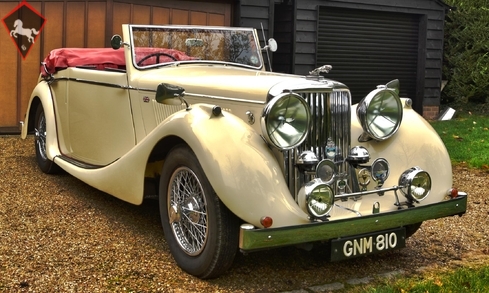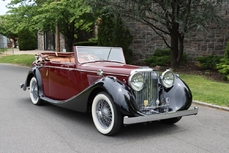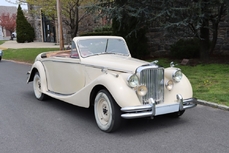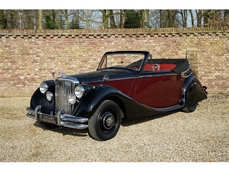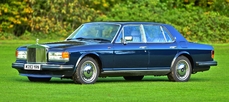Jaguar MkV Drophead Coupé IV 3 1/2 Litre 3 Position Drophead Coupe 1948
Allmän beskrivning :
Vintage and Presitge are Proud to offer this 1948 Jaguar MK IV 3 ½ Litre Three Position Drophead Coupe For Sale.
Manufactured in August 1948, chassis number '617141' was retailed via Henlys, London and first registered, as 'GNM 810', on 1st October '48. It is an original right-hand drive, three position drophead coupé, and is one of only 184 RHD models built.
Documentation on file states that the Jaguar was bought circa 1952/53 by Mr Brian Gent of Sherbourne Garage, Idle from Messrs Ebdons (Rootes dealers) of Cheltenham as a one-owner car. Shortly thereafter it was sold to Mr Peter Windle, a chartered surveyor of Appleby Bridge, who used the car for several years before consigning it to storage on his property. It was discovered there in 1975 and subsequently passed into the ownership of Jack Poole.
Restoration commenced around 1990, with the car evolving from there onwards while being used on a regular basis. It featured in Jaguar Quarterly magazine in 1992 with details of the restoration, including pictures, etc. The body was removed from the chassis, which was stripped to the bare frame with only minor repairs required.
All components were crack tested where possible. The engine block was found to be cracked so a replacement was sourced. The flywheel was refaced and a new layshaft found for the gearbox together with bearings, seals, etc. the braking system was overhauled and the front suspension rebuilt with new dampers, kingpins, bushes, etc.
Specialists in Bradford and Ripon re-trimmed the interior, which was completed with new carpets, re-covered door panels and rebuilt instruments. On completion in 1992, 'GNM 810' was considered to be the 'best in the world'.
In November 1997, Jack Poole sold the restored Jaguar to Mr Howard Seymour of Winchester, who used it extensively on events such as the Jaguar Drivers' Club Rally in the USA and JDC tours of Ireland and mainland Europe.
While in the Seymours' ownership, the car featured in Jaguar Monthly magazine (December 1999 edition, copy available). By that time, the Seymours had covered some 15,000 miles in the preceding two years; documentation on file shows that considerable further refurbishment was carried out during 1998 while the car was owned by them.
In August 2000, 'GNM 410' was acquired by Peter Clark of Beeston, Nottingham, during whose ownership the car was repainted by Stallion Motors in Nottingham. In addition, the cylinder head converted to unleaded compatibility; the rear axle rebuilt by Eric Battelle (in 2002); and a Getrag five-speed gearbox from M&C Wilkinson fitted, also in 2002. New wire wheels to original specification were fitted in 2003 together with new hubs all round.
In 2006 the interior woodwork was refinished by Coopers, while in 2007 a new bespoke carpet set was made by Graham Dean. There was an extensive engine rebuild in 2006, and in 2009 the shock absorbers were stripped and rebuilt.
In May 2015 a set of new chrome plated stainless steel wire wheels was fitted, shod with Dunlop Gold Seal tyres. A new mohair hood, with new West of England Cloth interior, was expertly fitted by Kevin Baggs, Poole-based hood specialist, in August 2015. The hood bag in finest Connolly hide matches the red leather seats.
GNM 810 featured in the Jaguar Drivers' Club's Jaguar Driver magazine in a three-page colour article (August 2015 edition); the October 2015 Regtransfers magazine in three-page colour article; and the December 2015 edition of the Jaguar Enthusiasts' Club's magazine in a three-page colour article. Noteworthy features of this unique car include: 1939 Lucas P100DB 'bull's eye' headlamps with figure-of-eight pattern lenses and vertical fluting; Lucas PLG40 spotlamps with tri-bars and correct lenses with vertical fluting; Lucas Long Windtone trumpet horns with optional wide mesh fronts; original Lucas wing mirrors; and an original radio aerial. Of particular interest are four rare badges: National Motorists Association, BRDC, BARC and JDC Members Car Club. The car also comes with an original SS tax disc holder containing a copy of the original 1948 tax disc; a complete set of original tools in the original tray, all fully restored; an original factory sales brochure, workshop manual and service book. The original four cream-painted wire wheels.
The comprehensive history file contains receipts from dozens of leading UK specialists, who have been exclusively entrusted with the supply of all parts and materials used. Two colour articles in the Jaguar Quarterly magazine of July 1992 detail the seven-year painstaking restoration by Jack Poole, while the Jaguar Monthly magazine of December 1999 details the two-year restoration by Howard Seymour , who took the car to USA and won many concours awards there. The file also contains records of the meticulous 13-year mechanical restoration by Peter Clark; a Jaguar Heritage Trust Certificate; and copies of old V5C registration documents.
Built on a generous 120" (3,048mm) wheelbase, the Mark IV retained a separate chassis featuring beam front and live rear axle suspension on semi-elliptic springs, lever-arm dampers, Burman worm-and-nut steering and Girling mechanical brakes. The stylish all-steel coachwork was available in saloon or drophead coupé forms and featured the kind of luxurious and well-appointed interior that would become a Jaguar hallmark. Used by SS Cars since 1934, the engine was Standard's rugged seven-bearing six which in Jaguar specification was fitted with a Weslake overhead-valve cylinder head and coupled to a four-speed manual gearbox; in 3½-litre form capable of propelling the sturdy Mark IV to over 95mph.
Top the Mark IV range was the decidedly voluptuous 3½-Litre Drophead Coupé, a full five seater that boasted an ingenious three-position hood giving occupants the choice of open, closed or coupé de ville motoring. Utilising the same all-steel body construction as its late 1930s SS Jaguar forebear, the newcomer appeared even more svelte thanks to a revised hypoid bevel rear axle that allowed the floor to be lowered by two inches.
http://www.vintagerollsroycecars.com/sales/1248/1948-jaguar-mark-iv-3-litre-three-position-drophead-coup/
1948 Jaguar MkV Drophead Coupé IV 3 1/2 Litre 3 Position Drophead Coupe is listed såld on ClassicDigest in Grays by Vintage Prestige for £110000.
Fakta i bilen
Karosstyp : Personbil Märke : Jaguar Modell : MkV Drophead Coupé Modellversion : IV 3 1/2 Litre 3 Position Drophead Coupe Motorvolym : 0.0 Årsmodell : 1948 Karosstyp : Coupé Läge : Essex
Såld
Information om säljaren
Såld
People who viewed this Jaguar MkV Drophead Coupé also viewed similar Jaguar listed at ClassicDigest
Other cars listed for sale by this dealer
om Jaguar
Åh, historien om Jaguar, från dess tidiga dagar som SS Cars Ltd. till sin höjdpunkt med D-typen och gatubilsevolutionen i form av den ikoniska E-typen. Det finns något alldeles brittiskt över denna berättelse, och jag ska berätta den som en brittisk journalist skulle göra.
I början:
Vår resa in i Jaguar-världen börjar på 1930-talet, när ett företag som kallades SS Cars Ltd. dök upp. Trots den olyckliga sammanträffandet av deras initialer med de stigande politiska spänningarna i Europa började de producera stilfulla och prestandainriktade bilar. SS 100, som introducerades 1936, var en symbol för elegans och hastighet och lade grunden för vad som skulle bli Jaguar.
Jaguars födelse:
När skuggan av andra världskriget närmade sig beslutade SS Cars Ltd. klokt att distansera sig från SS-initialerna. Så 1945 blev de officiellt Jaguar Cars Ltd., ett namn som snart skulle bli synonymt med brittisk lyx och prestanda.
XK-serien:
Jaguars efterkrigstid gav oss XK 120, en verklig sensation 1948. Med sin strömlinjeformade design och en kraftfull 3,4-liters raksexmoters blev den världens snabbaste seriebil. XK 120 var ritningen för det som komma skulle - Jaguar som förenade stil med hastighet på ett unikt brittiskt sätt.
D-typens dominans:
Sedan kom D-typen, en sann racinglegend. Introducerad 1954, vann den Le Mans tre gånger på 1950-talet och visade Jaguars tekniska skicklighet. Med sin innovativa monokokkonstruktion och den ikoniska fenan bak var D-typen höjdpunkten av Jaguars framgång inom motorsport.
E-typens framträdande:
Men den verkliga vändpunkten kom 1961 med introduktionen av E-typen, ofta beskriven av Enzo Ferrari som "den vackraste bilen som någonsin byggts". Dess långa motorhuv, böljande kaross och en 3,8-liters motor som levererade upphetsande prestanda gjorde den till en omedelbar klassiker. E-typen var inte bara en bil; den var ett konstverk på hjul och kunde nå 150 mph på vägen.
Gata och racingsuccé:
E-typens skönhet matchades av dess förmåga på racerbanan. De lätta E-typarna var särskilt framgångsrika i olika racingevenemang och cementerade Jaguars rykte som en kraft att räkna med inom motorsport.
Raffinemangets ålder:
När vi fördjupar oss i Jaguar-historien finner vi att 1950-talet och 1960-talet var en tid av raffinering och expansion. Tillsammans med den magnifika D-typen och den ikoniska E-typens framträdande introducerade Jaguar modeller som ytterligare befäste sitt rykte för lyx och prestanda.
MK2:
I slutet av 1950-talet presenterade Jaguar MK2, en sportig sedan som kombinerade elegans med kraft. Denna eleganta fyradörrars salong var en favorit bland bankrånare och polisen, tack vare dess exceptionella hastighet och hantering. MK2 var en symbol för Jaguars förmåga att förena sofistikering med prestanda och hade också en framgångsrik racingkarriär.
XJ6:
Hoppa fram till 1968 och Jaguar lanserade en bil som skulle definiera lyxbilar i decennier framöver - XJ6. Det var ett mästerverk i teknik och design med en jämn raksexmoters, oberoende bakre fjädring och en rymlig, vackert inredd interiör. XJ6 var en symbol för brittisk elegans och erbjöd en så smidig åktur att det kändes som om den gled över vägen. Den blev flaggskeppsmodellen för Jaguar och satte standarden för lyxbilar och visade en nivå av raffinering som imponerade på konkurrenterna.
Blandningen av klassiskt och modernt:
Medan MK2 och XJ6 representerade utvecklingen av Jaguars sedanmodeller, bibehöll de märkets engagemang för prestanda och lyx. Dessa bilar hörde inte bara hemma på racerbanan; de trivdes lika bra på de stora boulevarderna som på en avslappnad körning genom den engelska landsbygden.
Utmaningarna av förändring:
Men när 1970-talet närmade sig, ställdes Jaguar, liksom många brittiska biltillverkare, inför ekonomiska utmaningar och ägarförändringar. British Leyland-eran förde både möjligheter och svårigheter med sig när varumärket navigerade genom olika sammanslagningar och övergångar.
Ändå fortsätter arvet från MK2 och XJ6, tillsammans med D-typen och E-typen, att definiera Jaguar som en tillverkare som förenar tidlös elegans med en anda av prestanda. Dessa klassiska modeller, vare sig de körs på slingrande vägar eller står som samlarföremål, tjänar som ett vittnesbörd om Jaguars långvariga närvaro inom den automobila exklens värld.
Jaguar-historien, från dess tidiga dagar som SS Cars Ltd. till skapandet av ikoner som E-typen, MK2 och XJ6, är en resa som speglar essensen av brittisk bilkultur - en blandning av lyx, kraft och stil som fortsätter att fängsla entusiaster och samlare över hela världen.
